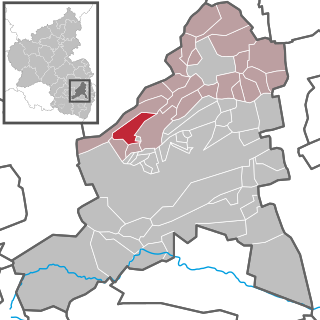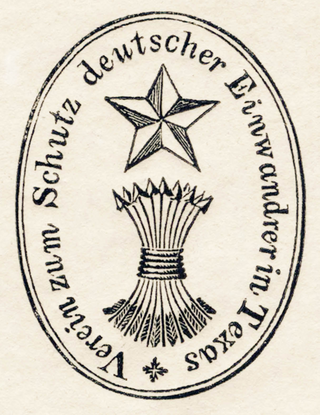
Westerburg is a small town of roughly 6,000 inhabitants in the Westerwaldkreis in Rhineland-Palatinate, Germany. The town is named after the castle built on a hill above the medieval town centre

The House of Leiningen is the name of an old German noble family whose lands lay principally in Alsace, Lorraine, Saarland, Rhineland, and the Palatinate. Various branches of this family developed over the centuries and ruled counties with Imperial immediacy.

Albrecht VII, Count of Schwarzburg-Rudolstadt was Count of Schwarzburg and founder of the Line of Schwarzburg-Rudolstadt, which later received the title of Prince.

Carlsberg is an Ortsgemeinde – a municipality belonging to a Verbandsgemeinde, a kind of collective municipality – in the Bad Dürkheim district in Rhineland-Palatinate, Germany.

The Mainzer Adelsverein at Biebrich am Rhein, better known as the Mainzer Adelsverein, organized on April 20, 1842, was a colonial attempt to establish a new German settlement within the borders of Texas.

Neuleiningen Castle is a ruin on the eastern edge of the Palatinate Forest in the state of Rhineland-Palatinate in Germany in the municipality of Neuleiningen in the Bad Dürkheim district. It was built in 1238-41 by Count Frederick III of Leiningen. The French destroyed it in 1690 and it has lain in ruins since that time.
Leiningen-Westerburg was an historic state of the Holy Roman Empire, located in the vicinity of Leiningen and Westerburg in what is now the German state of Rhineland-Palatinate.
Leiningen-Westerburg was an historic state of the Holy Roman Empire, located in the vicinity of Leiningen and Westerburg in what is now the German state of Rhineland-Palatinate.

Károly Leiningen-Westerburg was a German honvéd general in the Hungarian Army, and a member of the German House of Leiningen. He was executed for his part in the Hungarian Revolution of 1848, and is considered one of the 13 Martyrs of Arad.

The County of Leiningen consists on a group of counties, which were ruled by the Leiningen family.
Countess Johanna Magdalene of Hanau-Lichtenberg was a daughter of Johann Reinhard II of Hanau-Lichtenberg (1628–1666) and the Countess Palatine Anna Magdalena of Birkenfeld-Bischweiler (1640–1693).

Frederick I of Hesse-Homburg, was the first Landgrave of Hesse-Homburg and founder of the eponymous family line.
Ludowika Margaretha of Zweibrücken-Bitsch, was the only child and heiress of Count James of Zweibrücken-Bitsch by his wife Catherine, born Countess of Honstein zu Klettenberg. She was buried in Ingwiller.
Margaret Elisabeth of Leiningen-Westerburg, was a Countess of Leiningen and regent of the Landgraviate of Hesse-Homburg during the minority of her sons from 1638.
Balthasar of Nassau-Wiesbaden-Idstein was the youngest son of Count Philip I of Nassau-Wiesbaden-Idstein and his wife, Adriana of Glymes of Bergen, the daughter of John III of Bergen op Zoom.
Johanna Sibylla of Hanau-Lichtenberg was the first child of Philipp V, Count of Hanau-Lichtenberg from his first marriage with Countess Ludowika Margaretha of Zweibrücken-Bitsch (1540-1569).
Louis, Count Leiningen-Westerburg (1557–1622) was a German nobleman. He was a member of the House of Leiningen and was the ruling count of Leiningen-Leiningen from 1597 until his death.

Altleiningen is a castle in the Palatinate Forest in Germany. It lies in the parish of Altleiningen in the county of Bad Dürkheim in the German state of Rhineland-Palatinate.

The County of Zweibrücken-Bitsch was a territory of the Holy Roman Empire that was created between 1286 and 1302 from the eastern part of the County of Zweibrücken and the Barony of Bitche in Lorraine. It existed until 1570, when it was divided amongst its heirs when the counts died out.

The Barony of Westerburg, a small principality around the present day town of Westerburg in the Westerwald mountains of Germany, is first recorded in 1209. The eponymous castle, which had probably been built earlier than when it was mentioned for the first time in 1192, was the family seat of the lords of Westerburg, a branch of the lords of Runkel.











